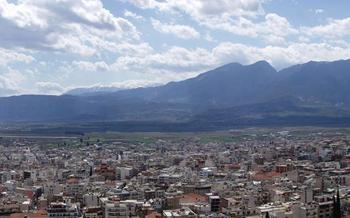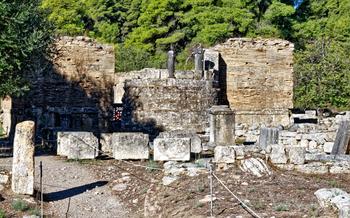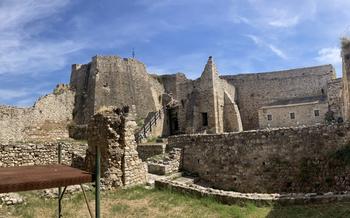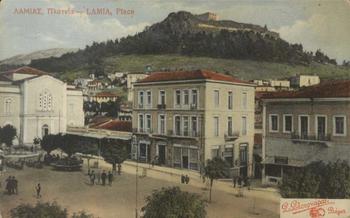
Domokos Castle
- Historical Background
- Architectural Features
- Exploration and Discovery
- Byzantine Legacy
- Ottoman Era:
- Restoration and Preservation
- Breathtaking Views
- Nearby Attractions
- Suggested Tours
- Photography Opportunities
- Cultural Events and Festivals
- Gastronomic Delights:
- Local Crafts and Souvenirs
- Insider Tip: Embracing Serenity at the Hidden Chapel
Historical Background
Domokos Castle, standing proudly in the heart of Greece, holds a rich and storied history that dates back to ancient times. Originally constructed as a Byzantine fortress in the 11th century, the castle played a pivotal role in safeguarding the empire's northern borders against relentless invasions. Its strategic location at the crossroads of major trade routes made it a crucial defensive stronghold, withstanding numerous attacks and sieges throughout the centuries.
During the Ottoman occupation of Greece, Domokos Castle underwent significant modifications to adapt to the new rulers' military requirements. The Ottomans reinforced the fortifications, adding towers and defensive structures to bolster its resilience against enemy advances. The castle served as a vital administrative center and military outpost, witnessing numerous battles and power struggles that shaped the region's destiny.
Over the centuries, Domokos Castle has borne witness to countless historical events, each etching its mark on the fortress's walls. From heroic triumphs to bitter defeats, the castle's legacy is intertwined with the struggles and triumphs of the Greek people. Today, it stands as a testament to their indomitable spirit and serves as a poignant reminder of the region's turbulent past.
Architectural Features
Domokos Castle stands as a testament to the ingenuity and defensive prowess of Byzantine and Ottoman engineers. Constructed using local stone and mortar, the castle's walls and towers display remarkable resilience. Its strategic position atop a hill allowed for optimal surveillance and defense of the surrounding landscape. The castle's fortifications include a series of towers, each serving a specific purpose. The main tower, known as the Keep, stands as the tallest and most prominent structure within the castle. Its imposing height and thick walls provided a final refuge in case of a breach. Smaller towers, strategically placed along the castle's perimeter, offered additional vantage points and defensive positions. These towers were connected by curtain walls, creating a formidable barrier against attackers. The castle's intricate system of gates and drawbridges further enhanced its security, allowing for controlled access and preventing unauthorized entry.
Exploration and Discovery
Visiting Domokos Castle is a captivating journey through history and architecture. To make the most of your experience, plan your visit during the spring or fall when the weather is pleasant. Avoid the summer crowds and aim for early mornings or late afternoons to capture the most enchanting light for photography.
Begin your exploration by approaching the castle from the west side, where you'll encounter the main entrance. Take your time to admire the imposing stone walls and fortifications that have stood for centuries. As you enter, you'll find yourself in a courtyard that once housed soldiers and provided shelter during times of conflict.
Explore the castle's various chambers, each with its own unique story to tell. Admire the well-preserved frescoes and intricate carvings that adorn the walls. Climb the narrow staircases to reach the upper levels, where you'll be rewarded with breathtaking views of the surrounding countryside.
For history enthusiasts, a guided tour is highly recommended. Knowledgeable guides will provide insights into the castle's past, sharing tales of battles, sieges, and the people who shaped its history. Alternatively, embark on a self-guided tour, allowing you to explore at your own pace and capture the castle's essence through your lens.
Byzantine Legacy
Domokos Castle stands as a testament to the Byzantine Empire's enduring influence on the region. Constructed during the 11th century, the castle served as a crucial defensive outpost and administrative center, guarding the empire's northwestern frontier. Its strategic location on the fertile Thessalian Plain made it a vital hub for trade and communication.
The Byzantines skillfully integrated the castle into their military and political strategies. Its massive fortifications, including stone walls, towers, and gates, provided a formidable defense against invading forces. The castle's garrison played a pivotal role in repelling attacks from neighboring states and preserving Byzantine control over the region.
Within the castle walls, the Byzantines established an administrative center that governed the surrounding territories. Officials and dignitaries resided within the castle, overseeing the collection of taxes, the administration of justice, and the maintenance of order. The castle also housed a church, a symbol of the Byzantine Empire's deep religious devotion.
The Byzantine legacy of Domokos Castle is evident in its architectural features and artifacts. The castle's construction reflects the Byzantines' mastery of military engineering, with its intricate defensive systems and imposing walls. Excavations at the site have uncovered Byzantine pottery, coins, and jewelry, offering glimpses into the daily lives of the castle's inhabitants.
Domokos Castle stands as a testament to the Byzantine Empire's strategic prowess and cultural influence. Its enduring legacy continues to shape the region's identity, connecting the present with a rich and vibrant past.
Ottoman Era:
During the Ottoman occupation of Greece, Domokos Castle played a significant role as a strategic military outpost. The Ottomans recognized the castle's defensive capabilities and made modifications to suit their own military needs. They reinforced the fortifications, added new towers and gates, and adapted the castle's layout to accommodate their troops and artillery. The Ottomans also used the castle as an administrative center, establishing a garrison and governing the surrounding region.
One notable event during the Ottoman period was the Battle of Domokos in 1821, which took place during the Greek War of Independence. Greek forces under the leadership of Athanasios Diakos attempted to capture the castle from the Ottomans but were unsuccessful. Diakos himself was captured and executed by the Ottomans, becoming a national hero in Greece.
The Ottoman influence on Domokos Castle can still be seen today in various architectural elements and features. The distinctive pointed arches, domed roofs, and intricate stonework reflect the Ottoman style of architecture. These elements blend harmoniously with the Byzantine foundations of the castle, creating a unique and captivating fusion of architectural styles.
Restoration and Preservation
Over the years, Domokos Castle has undergone extensive restoration and preservation efforts to maintain its historical integrity and architectural beauty. The process has been challenging, as the castle has faced various threats, including natural deterioration, neglect, and damage caused by past conflicts. Restoration work has involved meticulous attention to detail, using traditional techniques and materials to ensure authenticity. The efforts have been instrumental in preserving the castle's unique features, such as its fortified walls, towers, and gateways. Today, Domokos Castle stands as a testament to the dedication and commitment of those involved in its restoration, serving as a valuable historical and cultural landmark for future generations to appreciate and enjoy. Ongoing restoration projects and initiatives continue to safeguard the castle's legacy, ensuring its preservation for years to come.
Breathtaking Views
Domokos Castle offers breathtaking panoramic views that will leave you in awe. From the top of the castle, you can feast your eyes on a stunning tapestry of landscapes that stretch far and wide. Gaze upon the picturesque town of Domokos nestled amidst verdant valleys, its terracotta roofs contrasting beautifully with the surrounding greenery. Let your eyes wander to the majestic Pindus Mountains, their snow-capped peaks piercing the azure sky like ancient sentinels. On a clear day, you can even catch a glimpse of the shimmering waters of the Malian Gulf, reflecting the sun's golden rays. The views from Domokos Castle are not just visually stunning but also rich in historical significance. Each landmark, mountain, and valley holds stories of battles, conquests, and the passage of time. As you soak in the panoramic vistas, you'll feel a profound connection to the history and beauty of this remarkable region.
Nearby Attractions
Domokos Castle is surrounded by a wealth of historical and natural attractions that complement a visit to the castle. Just a short drive away, visitors can explore the ancient city of Lamia, with its well-preserved archaeological sites and museums. The picturesque village of Makrakomi, with its traditional architecture and stunning views of the surrounding countryside, is another must-see. For nature enthusiasts, the nearby Othrys Mountains offer a range of hiking trails and breathtaking scenery. The region is also home to several monasteries, including the historic Holy Monastery of Agios Georgios Domokou, which offer a glimpse into the rich religious heritage of the area. With its convenient location and easy accessibility, Domokos Castle serves as an ideal starting point for exploring the diverse attractions of the region.
Suggested Tours
Domokos Castle offers a variety of guided and self-guided tour options to enhance your exploration. Guided tours are an excellent way to delve deeper into the castle's history, architecture, and significance. Knowledgeable guides will lead you through the castle's halls, towers, and fortifications, sharing fascinating stories and insights. These tours typically last for around one to two hours and can be arranged through local tour operators or the castle's visitor center.
For those who prefer a more independent experience, self-guided tours are an excellent option. Maps and brochures are available at the castle's entrance, providing information on the various points of interest and historical highlights. Take your time exploring the castle's nooks and crannies, soaking in the atmosphere, and capturing stunning photographs. Audio guides are also available for rent, offering a self-paced tour with commentary and historical anecdotes.
Photography Opportunities
Domokos Castle presents a treasure trove of photographic opportunities for enthusiasts of all skill levels. The castle's picturesque scenery, unique architectural features, and stunning panoramic views make it a photographer's paradise. With its ancient walls bathed in golden sunlight, the castle offers a dramatic backdrop for capturing timeless images.
For the best lighting conditions, plan your visit during the early morning or late afternoon hours, when the soft, warm light enhances the castle's textures and colors. Experiment with different angles and perspectives to capture the castle's grandeur from various vantage points. The intricate details of the fortifications, the weathered stones, and the surrounding landscapes provide endless subjects for creative shots.
While photography is encouraged, it's essential to be respectful of the castle's historical significance and the privacy of other visitors. Follow any photography guidelines or restrictions displayed on-site, and avoid using flash or tripods that may disturb others.
To capture the castle's essence, consider using a wide-angle lens to encompass its sweeping vistas. For close-up shots, a macro lens will allow you to capture the intricate details of the architecture and carvings. Don't forget to experiment with different shutter speeds to convey a sense of movement or stillness, depending on your desired effect.
Whether you're a seasoned professional or a passionate amateur, Domokos Castle offers a wealth of photographic opportunities to create lasting memories of your visit to this historic landmark.
Cultural Events and Festivals
Domokos Castle is not just a historical landmark; it is also a vibrant cultural hub that hosts various events and festivals throughout the year. These events celebrate the rich heritage and traditions of the region and offer visitors a unique opportunity to immerse themselves in the local culture.
One of the most popular events is the annual Domokos Castle Festival, which takes place during the summer months. The festival showcases traditional Greek music, dance, and cuisine, with live performances, workshops, and demonstrations. Visitors can enjoy traditional Greek dishes, participate in dance lessons, and learn about the history and culture of the region.
Another highlight is the Medieval Festival, which transports visitors back in time to the days of knights and chivalry. The festival features jousting tournaments, medieval music and dance, and a variety of historical reenactments. Visitors can dress up in medieval costumes, witness exciting battles, and experience the atmosphere of a medieval village.
For those interested in history, the Domokos Castle Historical Symposium is a must-attend event. The symposium brings together historians, archaeologists, and scholars to discuss the castle's rich history and its role in shaping the region's cultural heritage. Visitors can attend lectures, panel discussions, and guided tours led by experts, gaining a deeper understanding of the castle's significance.
Gastronomic Delights:
After a day of exploring Domokos Castle and immersing yourself in its rich history, indulge in the delectable culinary offerings of the region. In the vicinity of the castle, you'll find a plethora of traditional Greek tavernas and restaurants serving up mouthwatering dishes that reflect the authentic flavors of the land. Savor the succulent grilled meats, fresh seafood, and crisp salads, all prepared with local ingredients and infused with the essence of Greek herbs and spices. Don't miss the opportunity to try regional specialties such as stifado (beef stew with onions and tomatoes) or kleftiko (slow-cooked lamb or goat). As you dine, soak in the convivial atmosphere and engage with the friendly locals, who will gladly share stories and recommendations to enhance your culinary journey. For a truly immersive experience, venture into the local markets or shops to discover an array of handmade delicacies, including aromatic cheeses, olives, honey, and traditional sweets. Supporting local artisans and purchasing these unique products not only ensures the preservation of traditional crafts but also contributes to the sustainability of the local economy.
Local Crafts and Souvenirs
After exploring Domokos Castle, immerse yourself in the local culture by browsing the vibrant markets or shops nearby. Discover unique handmade crafts, souvenirs, and traditional products that reflect the region's rich heritage. From intricately woven textiles and pottery to handcrafted jewelry and leather goods, there's something for every taste. Support local artisans by purchasing these one-of-a-kind items, helping to preserve traditional crafts and the livelihood of skilled craftspeople. The bustling atmosphere of the local markets, filled with friendly vendors and the scent of local delicacies, is an experience not to be missed. As you browse through the stalls, don't hesitate to engage with the locals and learn more about the stories behind these handmade treasures.
Insider Tip: Embracing Serenity at the Hidden Chapel
Venture beyond the main fortifications of Domokos Castle to discover a hidden gem nestled amidst the tranquil surroundings. Follow a secluded path that leads you to a small, unassuming chapel. This sacred space, often overlooked by visitors, exudes an aura of serenity and spirituality.
As you step inside, admire the simple yet elegant architecture and the warm glow of candlelight illuminating the interior. Take a moment to reflect and appreciate the peace and tranquility that envelops this hidden sanctuary. Let the silence wash away the distractions of the outside world, allowing you to connect with your inner self or pay homage to a higher power.
Remember, this chapel is a place of worship and reverence, so please be respectful and mindful of others who may be seeking solace within its walls. Embrace the opportunity to experience this hidden gem, a true oasis of tranquility within the historic confines of Domokos Castle.








